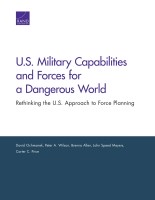| 来源类型 | Report
|
| 规范类型 | 报告
|
| DOI | https://doi.org/10.7249/RR1782-1
|
| 来源ID | RR-1782-1-RC
|
| U.S. Military Capabilities and Forces for a Dangerous World: Rethinking the U.S. Approach to Force Planning |
| David A. Ochmanek; Peter A. Wilson; Brenna Allen; John Speed Meyers; Carter C. Price
|
| 发表日期 | 2018-11-28
|
| 出版年 | 2017
|
| 语种 | 英语
|
| 结论 | - The U.S. Department of Defense (DoD) continues to use a Two Regional Wars standard for force planning, although this standard now bears little relationship to what the administration and the nation expect U.S. armed forces to be prepared to do.
- Important national interests today are being challenged by two major powers — Russia and China — that pose operational and strategic challenges that far outstrip those posed by the regional adversaries that animate DoD's current force planning construct (FPC).
- With its growing arsenal of nuclear weapons and ballistic missiles, North Korea today presents threats for which U.S. and allied forces lack satisfactory answers.
- Although the United States and its allies and partners have made considerable headway in blunting the threat posed by al Qa'ida and its affiliates, U.S. forces must expect to be engaged in the struggle with Salafist-jihadi groups, such as ISIS, for many years to come.
- Addressing the challenges posed by the most-capable adversaries generally calls not for a larger U.S. force but rather for a force equipped with appropriate modern weapons and support assets that is also postured for responsive and resilient operations in theaters of potential conflict.
|
| 摘要 | This report evaluates the capabilities of current and programmed U.S. forces to meet the demands of conflicts that could arise involving any of five potential adversaries: China, Russia, North Korea, Iran, and Salafist-jihadi groups worldwide. The report finds that U.S. forces today are larger than necessary to fight a single major war, are failing to keep pace with the modernizing forces of great power adversaries, are poorly postured to meet key challenges in Europe and East Asia, and are insufficiently trained and ready to get the most operational utility from many of its active component units. The report recommends a host of enhancements to the capabilities and posture of U.S. forces and offers three alternative force planning constructs to help ensure that defense resources are, in the future, applied to the highest-priority needs. |
| 目录 |
Chapter One
The Need for a New Approach to Force Planning
Chapter Two
China: Ensuring Access to the Air and Sea Commons and Sustaining Capabilities for Effective Power Projection Operations
Chapter Three
Responding to Russia's Remilitarization of Geopolitics in Europe
Chapter Four
Countering a Nuclear-Armed North Korea
Chapter Five
Countering Iranian Aggressiveness and Maintaining Balance in the Persian Gulf Region
Chapter Six
Combating Salafist-Jihadi Groups: The Roles Played by U.S. SOF
Chapter Seven
Alternative Force Planning Constructs and Associated Forces
Appendix A
The Third Offset and the Future of DoD's R&D Investment Portfolio
Appendix B
On the Future of the U.S. Nuclear Posture
Appendix C
Estimating the Costs of Alternative Future Forces: Assumptions and Approach
Appendix D
Sizing Force Elements for Alternative Force Planning Constructs
|
| 主题 | Counterterrorism
; Military Force Planning
; Military Transformation
; Nuclear Weapons and Warfare
; Security Cooperation
|
| URL | https://www.rand.org/pubs/research_reports/RR1782-1.html
|
| 来源智库 | RAND Corporation (United States)
|
| 引用统计 |
|
| 资源类型 | 智库出版物
|
| 条目标识符 | http://119.78.100.153/handle/2XGU8XDN/523687
|
推荐引用方式
GB/T 7714 |
David A. Ochmanek,Peter A. Wilson,Brenna Allen,et al. U.S. Military Capabilities and Forces for a Dangerous World: Rethinking the U.S. Approach to Force Planning. 2018.
|
|
文件名:
|
RAND_RR1782-1.pdf
|
|
格式:
|
Adobe PDF
|
|
文件名:
|
1543954566320.jpg
|
|
格式:
|
JPEG
|

除非特别说明,本系统中所有内容都受版权保护,并保留所有权利。
